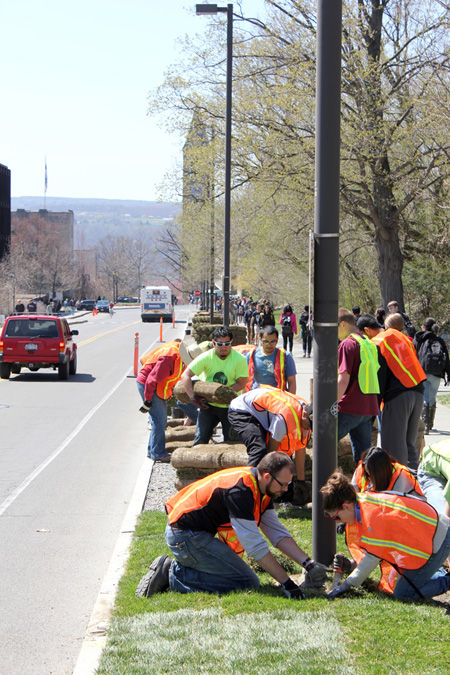 By Celine Jennison ‘14. Cross-posted from CALS Notes.
By Celine Jennison ‘14. Cross-posted from CALS Notes.
Have you ever wondered why the grass along Tower Road looked so miserable even though it runs alongside the Plant Sciences building?
A group of students from the “Grassing the Urban Eden” class (HORT 4931) recently re-sodded the side of the road, from Garden Avenue towards Day Hall, to transform the grim strips along the sidewalk into a long green carpet in just an hour.
This was done as part of an experiment led by two professors from the Department of Horticulture, Nina Bassuk and Frank Rossi. Frustrated with how the unhealthy grass suffered from soils laden with de-icing salts and compacted by foot traffic and winter maintenance vehicles, the two professors joined forces with the Cornell Grounds Department and the Cornell University Agricultural Experiment Station to test solutions to this problem.
Bassuk brought her expertise with soil. She had previously invented CU Structural Soil to promote tree health in urban environments where roots suffer from compaction, inadequate water, nutrient and oxygen levels. Her soil has a 8:2 stone to soil ratio and hydrogel, a binding agent and water holding gel to prevent stones and soil from separating during the mixing and installation process.
Rossi lent his knowledge about grass. He recommended 90 percent tall fescue – “the most idiot-proof grass you can get” – and 10 percent Kentucky bluegrass, a common cool-season species used in sod production. Fescue can withstand traffic, salt and drought, but is a “bunch-type” grass; the addition of bluegrass helps knit together a sturdy sod.
The experiment on Tower Road involves installing sod from CALS alumni Laurie and Steve Griffen ‘84 of Saratoga Sod, on top of CU Structural Soil to see how well the grass performs at different depths: 6, 8 and 10 inches deep. Wireless in-ground sensors will later be added to monitor temperatures, moisture and salinity.
As a plant science major who walks along Tower Road every morning, I look forward to monitoring the grass performance and seeing for myself whether this technique is one solution to greening cities and making passers-by happier.


